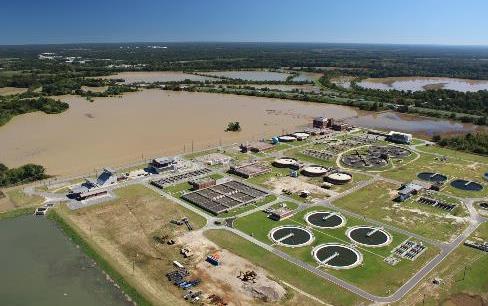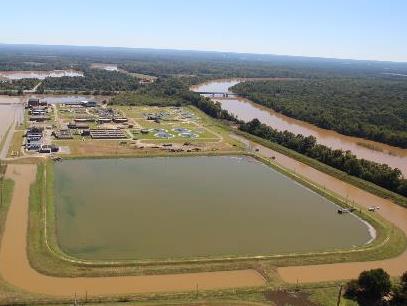The Metro Wastewater Treatment Plant’s (WWTP) Response to Adversity
CW2020 Employee Newsletter Vol. 4, No. 1

Emergency plans were set into motion in late September when heavy rain from Hurricane Joaquin was forecasted to impact the City. From September 30, during the historic flood, and into the weeks following, the staff at the Metro Wastewater Treatment Plant went well above and beyond the call of duty to keep the system running, while also ensuring reliable service that fully complied with regulatory requirements.
In preparation for inclement weather, the plant stocked the fuel and chemicals required to maintain treatment operations. These deliveries arrived until Saturday, October 3, when trucks were barely able to make it to the plant because flood waters were rising around the plant and access road were flooded.
With flood waters rising and arriving at the plant safely becoming an issue, staff were reduced to essential employees. This was not business as usual. Typically, the plant operates with a staff of 70 to 75 on a 24/7 basis. With swelling rivers, dam breaks across the City, and the heavy rain that fell on Sunday, the plant was facing unprecedented inflow. Additionally, the South Carolina Department of Health and Environmental Control (DHEC) issued a warning that the Lake Murray dam was opening its remaining spillways, and Metro WWTP should consider shutting down the plant and evacuating due to the fear of the levee breaching. City of Columbia leadership met to review conditions and after careful consideration, all but five individuals were evacuated via the flooded access road on the afternoon of October 4. The five volunteers were tasked with operating and maintaining the treatment process to meet the regulatory requirements. On the morning of October 6, the facility began 48 hour rotations of staff. From that point forward, a team of six operators and two maintenance technicians maintained plant operations, while a similarly sized team began assessing and repairing the collection system pump stations. Supervisors arranged for food and other supplies, such as cots, to be delivered to the plant, which was accomplished through a makeshift road to Interstate 77 and a subsequent path up its wooded embankment.
While the plant was being managed by just a few employees, it was also seeing record breaking inflows. In 1996, the Metro Wastewater Treatment Plant was upgraded to handle 60 million-gallons-per-day (MGD). By the end of the day Saturday, October 3, the plant had received nearly 87 million gallons. This was followed by 120 million gallons on Sunday, 156 million gallons on Monday, and an average of 69 MGD for the following three weeks. Such a big challenge only motivated the team to do even more. Shutting off the system was not an option. If the plant had been shut off, raw sewage could have poured into the river, all around the plant, through city pipelines and up through manholes in the City, drastically impacting Columbia’s citizens.
Because there was an extreme influx of water, the team devised a nontraditional method of running portions of the treatment system at alternating intervals to keep the healthy microorganisms from washing away. This nontraditional plan of action also allowed the team to make hands-on adjustments to the nutrients needed by the microorganisms. The plan was working perfectly when the plant suddenly lost power. A short time later power was restored; however, declining water pressure threatened various pumps. Thankfully, the dedicated staff on the potable water side of the City department had the water pressure restored relatively quickly.
Metro WWTP Superintendent, David Wiman, describes the importance of healthy microorganisms (bugs) in day-to-day treatment of wastewater:
“We’re dealing with microbiology and chemistry. The bugs must be kept alive inside the basins, (and) we need the right kind of bugs. So to feed them, we basically have a conveyor belt of food, and we need to have the right amount of food on the conveyor, so that when the bugs eat there's not much food left on the conveyor and everybody’s full.”
Sustaining natural processes such as these takes determination. And, during a flood, it takes human power and ingenuity to create procedures where there are none. Wiman reflected, “I pulled out our manual and I opened it up to Twice Design Peak and the pages were blank.” However, the operations team was up to the task and put processes into place that worked. With this new technique working, they kept it up throughout the flood, working 48 hour shifts and braving the 6 feet of water around the plant for basic necessities.
takes human power and ingenuity to create procedures where there are none. Wiman reflected, “I pulled out our manual and I opened it up to Twice Design Peak and the pages were blank.” However, the operations team was up to the task and put processes into place that worked. With this new technique working, they kept it up throughout the flood, working 48 hour shifts and braving the 6 feet of water around the plant for basic necessities.
It was not until October 14 that the plant could return to full staff. And, as flood waters around the plant began to recede, it became apparent that the team’s labors were not in vain. Lab tests confirmed that levels were in the acceptable range. For example, regulations require that the facility not average more than 45 Mg/L of Total Suspended Solids or Biochemical Oxygen Demand during any one week; the facility averaged 14.3 and 7.6 Mg/L respectively during the first week of October, well below the weekly maximum average and the monthly average of 30 Mg/L for these two parameters. Thus, regulatory compliance was retained, no sewage was spilled into the river, and the Metro Wastewater Treatment Plant did not shut down during the most disastrous flooding the plant has ever seen.
The plant staff prepared for an emergency weather situation and dealt with a crisis of proportions no one ever expected in the most heroic and unyielding manner possible. The dedication of the Metro Wastewater Treatment Plant staff is unparalleled and we are very grateful to the men and women who sacrificed for our City.